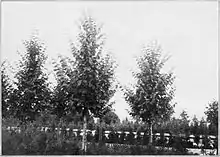Ulmus × hollandica 'Fastigiata'
The hybrid elm cultivar Ulmus × hollandica 'Fastigiata' was first listed and described as Ulmus glabra fastigiata, a narrow-crowned elm with large smooth leaves, by Petzold and Kirchner in Arboretum Muscaviense (1864).[1] C. Berndt of the Berndt Nursery, Zirlau, Schweidnitz, described an elm of the same name in Mitteilungen der Deutschen Dendrologischen Gesellschaft (1915, including a photograph), that he had received in 1903 "from a renowned nursery in Holstein" as Ulmus montana fastigiata macrophylla. A tree of that name had been listed by Dieck in 1885 without description.[2] Berndt reported that his U. glabra fastigiata was "easy to confuse with U. montana superba", a tree "known in the Magdeburg region as Ulmus praestans", a statement confirming that, like that cultivar, his tree was a form of U. × hollandica.[3] Karl Gustav Hartwig who received specimens of U. praestans from Kiessling of the Magdeburg city nursery in 1908, concluded (1912) that U. glabra fastigiata Kirchner was indistinguishable in leaf or habit from U. praestans.[4] An U. campestris glabra fastigiata Arb. Musc. [ = Kirchner] was distributed by the Hesse Nursery, Weener, Germany, in the 1930s, where it was listed separately from U. praestans.[5]
| Ulmus × hollandica 'Fastigiata' | |
|---|---|
 Ulmus glabra fastigiata, Zirlau, Silesia (1915) | |
| Hybrid parentage | U. glabra × U. minor |
| Cultivar | 'Fastigiata' |
| Origin | Germany |
The Späth nursery of Berlin marketed an U. montana fastigiata glabra in the 1890s and early 1900s.[6] Bean (1925) listed an U. glabra 'Fastigiata Stricta' (1925).[7]
Not to be confused with Exeter Elm, Loudon's U. montana fastigiata (1838)[8] and Elwes and Henry's U. montana var. fastigiata (1913).[9]
Description
Kirchner's Ulmus glabra fastigiata was narrow-crowned, with large smoothish leaves of firmer texture than his Ulmus glabra Mill.. Berndt's Ulmus glabra fastigiata was a tree of tight narrow pyramidal growth, the leaf being dark, acuminate, irregularly veined, and often wider at the top than lower down. Berndt reported the tree as "less vigorous than Ulmus montana superba" [ = U. praestans].[3]
Cultivation
Ulmus glabra fastigiata was cultivated in Silesia by the Berndt Nursery, Zirlau, Schweidnitz, in the early 20th century. Berndt reported that, though stocked in only a few nurseries, it was praised at the 20th Century Exhibition in Breslau. No specimens are known to survive.
References
- Petzold and Kirchner in Arboretum Muscaviense (Gotha, 1864), p.560
- Dieck, Georg (1885). Haupt-catalog der Obst- und gehölzbaumschulen des ritterguts Zöschen bei Merseburg. Zöschen. p. 82.
{{cite book}}: CS1 maint: location missing publisher (link) - Berndt, C. (1915). "Notizen über Ulmen". Mitteilungen der Deutschen Dendrologischen Gesellschaft. 24: 288. Retrieved 18 October 2017.
- Hartwig, Karl Gustav (1913). "Ulmus praestans". Mitteilungen der Deutschen Dendrologischen Gesellschaft. 22: 302.
- Hesse, Hermann Albert (1932). Preis- und Sortenliste. pp. 96–97. Retrieved 18 January 2018.
- Katalog (PDF). Vol. 108. Berlin, Germany: L. Späth Baumschulenweg. 1902–1903. pp. 132–133.
- Bean, W. J. (1925 edn.) Trees and shrubs hardy in Great Britain, London
- Arboretum et Fruticetum Britannicum, 3: 1399 (1838)
- Elwes, H. J. & Henry, A. (1913). The Trees of Great Britain & Ireland. Vol. VII.